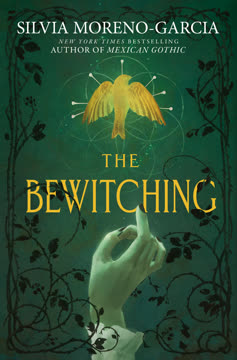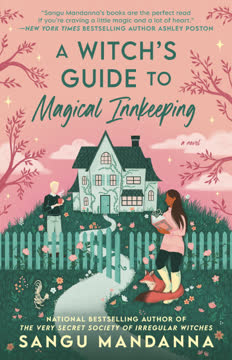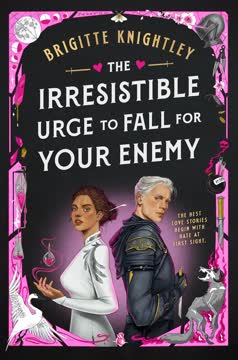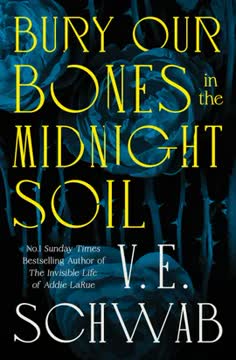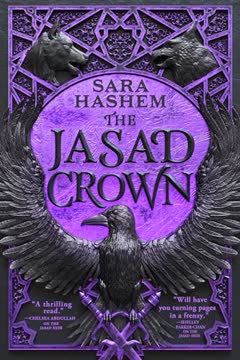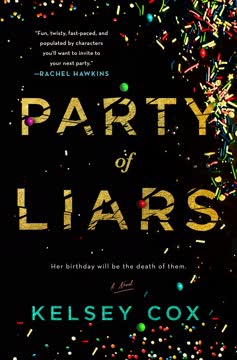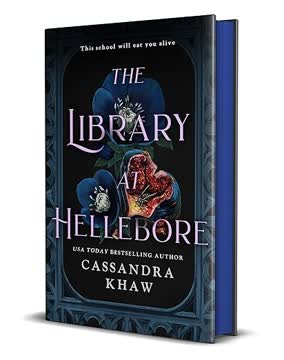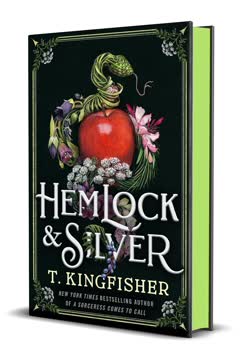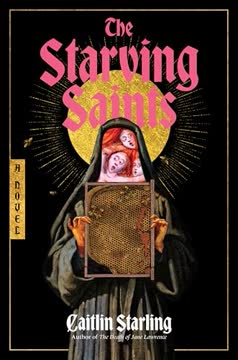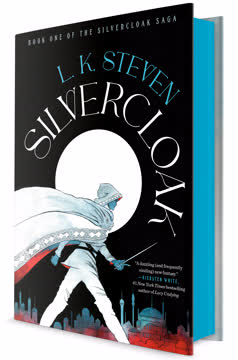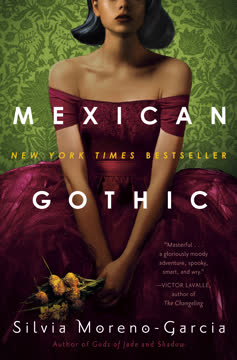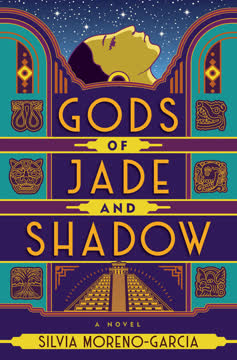Plot Summary
Witches in the Trees
Minerva Contreras, a Mexican graduate student at Stoneridge College in New England, is haunted by her great-grandmother's tales of witches and the eerie landscape of her new home. The campus, with its Victorian houses and the mysterious Briar's Commons—dubbed the Witch's Thicket—feels alive with old stories. Minerva, struggling with her thesis on forgotten horror writer Beatrice Tremblay, is isolated and anxious, feeling the weight of both her family's expectations and the supernatural atmosphere. The peacocks on campus, the old haunted dorms, and the stories of vanished girls all blend into a tapestry of unease. Minerva's sense of being watched and her inability to shake off the feeling of impending doom set the tone for a summer where the past and present, myth and reality, will collide.
The Vanishing Scholar
Minerva's research into Beatrice Tremblay's work leads her to the unsolved disappearance of Virginia Somerset in 1934, a case that inspired Tremblay's cult horror novel, The Vanishing. As Minerva navigates the college's archives and the social politics of the campus, she discovers that another student, Thomas Murphy, has also gone missing under mysterious circumstances. Both disappearances are shrouded in rumors of witchcraft, strange symbols, and a sense of being hunted. Minerva's encounters with the privileged but troubled Noah Yates, whose grandmother Carolyn holds the key to Tremblay's private papers, draw her deeper into a web of secrets that link the present to the haunted past.
Bloodlines and Portents
Interwoven with Minerva's story is the tale of Alba Quiroga in 1908 Mexico, whose family is beset by tragedy and whispers of witchcraft. Alba's brother vanishes, animals die mysteriously, and the land seems cursed. Alba's portents—her ability to sense coming doom—mirror Minerva's own feelings of dread. Both women are marked by their bloodlines: Alba's family is said to be "witchborn," and Minerva's great-grandmother survived a supernatural ordeal. The narrative explores how trauma, folklore, and inherited gifts shape the destinies of women across generations, binding them to cycles of violence and resistance.
The Witch's Thicket
Briar's Commons, the Witch's Thicket, is both a literal and symbolic heart of the novel. It is the site of vanished girls, ghostly lights, and the setting for both historical and contemporary hauntings. For Minerva, it is a shortcut and a source of anxiety; for Ginny Somerset in 1934, it is the last place she is seen alive. The Thicket becomes a liminal space where the boundaries between the living and the dead, the mundane and the magical, blur. It is here that the sense of being followed, of evil lurking just out of sight, is most acute, and where the stories of the vanished are most keenly felt.
Ghosts of Joyce House
Joyce House, the oldest dorm on campus, is a nexus of supernatural activity. Minerva discovers witch marks carved into its woodwork and hidden beneath its floorboards—apotropaic symbols meant to ward off evil. The ghost of Ginny Somerset lingers here, her presence felt in cold drafts, strange noises, and the sense of unfinished business. Minerva's investigation uncovers a note Ginny left behind, naming her murderer, and reveals that the past is not as distant as it seems. The dorm becomes a battleground between protective magic and predatory sorcery.
The Unseen Foe
As Minerva delves deeper into her research, she becomes the target of a malevolent force. She experiences portents—headaches, anxiety, the feeling of being watched—and is stalked by an entity that leaves dead animals and witch marks at her door. The attacks escalate, echoing the experiences of Ginny and Alba before her. The novel blurs the line between psychological breakdown and supernatural assault, using the motif of the "unseen foe" to explore how women are gaslit, isolated, and hunted by both human and inhuman predators.
The Black List
Beatrice Tremblay and Edgar Yates, haunted by Ginny's disappearance, keep a "Black List" of missing persons—cases with uncanny elements, unsolved and unsettling. This scrapbook of vanished people becomes a symbol of the novel's central concern: the erasure of women's stories, the persistence of trauma, and the need to remember. Minerva's discovery of the Black List ties her own research to a lineage of seekers and mourners, and underscores the cyclical nature of violence and forgetting.
Curses and Consequences
The narrative reveals that curses are not just the work of folklore, but of real, predatory witches—most notably Carolyn Yates and her father, the Wingraves. Their magic is fueled by the blood and fear of the gifted, and their ambition leaves a trail of ruined lives. Alba's uncle Arturo, a warlock, is similarly revealed as the source of her family's suffering. The consequences of their actions ripple across generations, showing that the pursuit of power—magical or otherwise—demands a terrible price from the vulnerable.
The Witchborn
Minerva, Alba, Ginny, and Beatrice are all "witchborn" in different ways—marked by blood, talent, or trauma. The novel explores how women inherit not just curses, but also the tools to resist them: portents, protective magic, and the power of storytelling. The struggle to survive, to remember, and to fight back is at the heart of their journeys. The witchborn are both hunted and hunters, victims and avengers, and their stories are acts of defiance against erasure.
The Factory's Secret
The abandoned Wingrave factory is the scene of past and present horrors. It is where Ginny and Santiago were murdered, where Thomas Murphy met his end, and where Minerva is brought for the final confrontation. The factory, with its red fibers and lingering ghosts, is a symbol of industrial decay, generational rot, and the hidden violence of the powerful. It is here that the truth about the Wingraves' crimes is revealed, and where Minerva must use both inherited magic and her own cunning to survive.
The Poisoned Heart
Minerva, drawing on the wisdom of her great-grandmother and the stories of Alba, prepares a magical poison—wine laced with ashes, salt, and moth wings—to use against Carolyn. In a parallel from the past, Alba uses a similar ruse to defeat her uncle Arturo. Both women allow themselves to be bitten, turning the predator's hunger into a weapon. The motif of the "poisoned heart" is both literal and metaphorical: the heart is the seat of power, love, and vulnerability, and it is through sacrifice and cunning that the witchborn can strike back.
The Final Spell
The climactic confrontations in both timelines—Minerva versus Carolyn, Alba versus Arturo—are brutal, intimate, and charged with both horror and catharsis. The witches are decapitated, their bodies dissolving into dust, their curses broken. The ghosts are freed, the cycle of violence interrupted, if not ended. The final spell is not just an act of magic, but of will: the refusal to be consumed, the determination to live through it, and the power to name and destroy evil.
After the Witching
In the aftermath, Minerva and Alba are left to pick up the pieces. The world is not magically healed—trauma lingers, scars remain, and the threat of new witches persists. Minerva is wary of Noah, who may or may not inherit his family's power. Alba prepares to raise her child, uncertain of what the future holds. Both women are changed, marked by their ordeals, but they have survived. The novel refuses easy closure, acknowledging that evil is never fully vanquished, only held at bay.
The Legacy of Shadows
The epilogue and afterword reflect on the importance of remembering, of telling stories, and of honoring the lost. Minerva, now a survivor and a scholar, tends to her wards, carves witch marks, and keeps the memory of Ginny, Alba, and the others alive. The legacy of shadows is both a warning and a call to action: to resist the forces that would erase women's stories, to recognize the persistence of evil, and to find strength in community, memory, and magic.
The Familiar's Watch
Minerva, watched over by the ghost of her cat, continues to guard her home and her story. The familiar—a symbol of both vulnerability and power—reminds her that the world remains dangerous, but also that she is not alone. The final image is one of cautious hope: the witch marks on the door, the memory of the dead, and the promise to keep watch against the return of the witches.
Characters
Minerva Contreras
Minerva is a Mexican graduate student at Stoneridge College, driven by ambition, haunted by family folklore, and isolated by her outsider status. Her psychological landscape is shaped by anxiety, depression, and a deep sense of being watched—by both the supernatural and the social structures around her. Minerva's relationships are marked by distance and wariness, but she is fiercely loyal to her friends and to the memory of her great-grandmother, Nana Alba. Her development is a journey from passive victim to active resister: she learns to trust her portents, to wield protective magic, and to confront the predatory witches who threaten her. Minerva's story is one of survival, self-discovery, and the reclamation of erased histories.
Alba Quiroga
Alba, living in 1908 Mexico, is a young woman beset by tragedy—her brother's disappearance, the death of animals, and the encroachment of a family curse. She is sensitive, artistic, and marked by portents, able to sense coming doom. Her relationship with her uncle Arturo is fraught with both affection and horror, as he is revealed to be the warlock behind her family's suffering. Alba's psychological arc is one of grief, rage, and ultimately agency: she moves from helplessness to decisive action, using both cunning and inherited magic to destroy the predator in her midst. Her story is a meditation on the costs of survival and the complexities of love, power, and resistance.
Carolyn Yates (née Wingrave)
Carolyn is the elegant, imperious matriarch of the Yates family, a powerful witch whose magic is fueled by the blood and fear of the gifted. She is both charming and ruthless, using her wealth, social status, and supernatural abilities to manipulate and destroy. Carolyn's psychological makeup is defined by ambition, entitlement, and a chilling lack of empathy. Her relationships—with her grandson Noah, with her victims, and with her own past—are transactional and predatory. She is the embodiment of generational evil, a force that consumes and erases the vulnerable for her own gain.
Beatrice "Betty" Tremblay
Beatrice is a scholar, writer, and survivor, whose life is shaped by the disappearance of her friend Ginny Somerset. She is introspective, haunted, and determined to remember and record what others would forget. Her correspondence, journals, and stories become a lifeline for Minerva and a testament to the persistence of trauma. Beatrice's psychological journey is one of mourning, guilt, and the search for meaning in the face of loss. She is both a chronicler and a participant in the cycle of violence that haunts Stoneridge.
Virginia "Ginny" Somerset
Ginny is a vibrant, eccentric art student in 1934, marked by her Spiritualist beliefs and her ability to communicate with the dead. She is both beloved and ostracized, her difference making her a target for predatory witches. Ginny's psychological state deteriorates as she is stalked, gaslit, and ultimately murdered by Carolyn and her father. Her ghost lingers, a symbol of unfinished business and the erasure of women's stories. Ginny's fate is a warning and a call to remember the lost.
Noah Yates
Noah is Carolyn's grandson, a privileged but disaffected young man who straddles the line between victim and potential predator. His relationship with Minerva is fraught with tension, attraction, and suspicion. Psychologically, Noah is marked by a sense of inadequacy, resentment, and the burden of his family's legacy. He is both a possible inheritor of Carolyn's power and a potential threat to Minerva, embodying the uncertainty of whether cycles of violence will continue or be broken.
Arturo Velarde
Arturo, Alba's uncle, is a sophisticated, charismatic man whose ambition and magical hunger devastate his family. He is both a beloved figure and a monster, capable of affection and unspeakable cruelty. Arturo's psychological complexity lies in his self-justification, his sense of entitlement, and his inability to escape his own nature. His relationship with Alba is a twisted dance of desire, manipulation, and violence, culminating in a fatal confrontation.
Valentín Pimentel
Valentín is Alba's childhood friend and would-be suitor, a kind and practical young man who believes in the old ways and tries to help Alba fight the curse on her family. His psychological makeup is defined by loyalty, courage, and a sense of duty. Valentín's fate—murdered by the warlock he tries to oppose—underscores the dangers faced by those who stand against predatory power.
Thomas Murphy
Thomas is a quiet, studious student at Stoneridge who becomes obsessed with the story of Ginny Somerset and the occult. His research and disappearance mirror Ginny's fate, suggesting that the cycle of predation and erasure continues into the present. Thomas's psychological arc is one of curiosity, fear, and ultimately victimhood, his story a warning about the dangers of seeking forbidden knowledge.
Hideo Ogawa
Hideo is Minerva's colleague and confidant, a fellow resident director and English student. He provides comic relief, practical support, and a grounding presence amid the escalating supernatural threats. Psychologically, Hideo is pragmatic, loyal, and skeptical, serving as a foil to Minerva's growing belief in magic and danger. His friendship is a lifeline for Minerva, reminding her of the importance of community and care.
Plot Devices
Dual Timelines and Interwoven Narratives
The novel employs a structure of interwoven timelines—Minerva in 1998, Alba in 1908, and Beatrice/Ginny in 1934—to draw connections between women across time, showing how curses, violence, and resistance echo through generations. This device allows for foreshadowing, dramatic irony, and the gradual revelation of secrets, as each timeline sheds light on the others. The structure emphasizes the persistence of trauma and the cyclical nature of predation and survival.
Witch Marks and Apotropaic Magic
Witch marks—carved symbols, hidden charms, and talismans—are central to the novel's supernatural logic. They serve as both protective barriers and narrative clues, guiding Minerva's investigation and marking sites of violence. The marks are a visual motif that ties together the stories of Alba, Ginny, and Minerva, and their effectiveness (or failure) is a commentary on the limits and possibilities of resistance.
The Unseen and the Unnamed
The novel uses the motif of the unseen—entities that stalk, voices that whisper, threats that are felt but not seen—to create psychological terror and to mirror the ways in which women's suffering is often ignored or dismissed. The refusal to name the witch, the ambiguity of Noah's inheritance, and the uncertainty of the ghosts' presence all contribute to an atmosphere of dread and uncertainty.
The Black List and the Power of Storytelling
The Black List—a scrapbook of missing persons and ghost stories—serves as both a literal and metaphorical device. It is a record of the lost, a refusal to forget, and a symbol of the power of storytelling to resist erasure. The act of writing, remembering, and naming is itself a form of magic, a way to fight back against those who would consume and destroy.
Poison as Reversal
Both Alba and Minerva use the motif of the poisoned heart—allowing themselves to be bitten, but lacing their blood with magic or poison—to turn the predator's hunger against them. This device subverts the traditional victim/predator dynamic, allowing the hunted to become the hunter. It is a metaphor for agency, cunning, and the refusal to be consumed.
Foreshadowing and Portents
Portents—headaches, dreams, feelings of dread—are used throughout the novel to foreshadow danger and to connect the witchborn women across time. These moments of intuition are both warnings and calls to action, urging the characters to trust their instincts and to prepare for confrontation.
Analysis
The Bewitching is a masterful blend of horror, historical fiction, and feminist commentary, using the language of witchcraft and folklore to explore the intergenerational trauma inflicted by predatory power—both supernatural and societal. Through its interwoven timelines and richly drawn characters, the novel interrogates the ways in which women are hunted, silenced, and erased, but also how they resist, remember, and reclaim agency. The motif of the "witchborn" is both a curse and a source of strength, suggesting that survival depends on the ability to recognize danger, trust intuition, and wield the tools of both tradition and innovation. The novel's refusal to offer easy closure—its acknowledgment that evil persists, that memory is fragile, and that vigilance is necessary—makes it a resonant and unsettling meditation on the costs and possibilities of resistance. Ultimately, The Bewitching is a story about the power of naming, the necessity of remembering, and the enduring struggle to carve out safety and meaning in a haunted world.
Last updated:
FAQ
Synopsis & Basic Details
What is The Bewitching about?
- Dual Timelines Unfold: The Bewitching weaves together two compelling narratives: Minerva Contreras, a Mexican graduate student in 1998 New England, grappling with her thesis on a forgotten horror writer and a mysterious campus disappearance; and Alba Quiroga, a young woman in 1908 rural Mexico, whose family is plagued by vanishing loved ones and strange occurrences. Both women are "witchborn," inheriting a sensitivity to the supernatural and a destiny intertwined with ancient, malevolent forces.
- Unraveling Hidden Horrors: The novel delves into the chilling mystery of Virginia Somerset, a student who vanished in 1934, whose story inspired the very book Minerva is researching. As Minerva uncovers unsettling parallels between Virginia's fate and a contemporary disappearance on campus, she realizes she is being targeted by the same predatory magic that haunted women across generations.
- A Fight for Survival: At its core, the story is a suspenseful exploration of intergenerational trauma, the power of folklore, and the resilience of women confronting unseen, yet very real, evil. Both Minerva and Alba must learn to trust their instincts and harness their inherited gifts to fight back against charming, ruthless warlocks and witches who feed on fear and blood.
Why should I read The Bewitching?
- Rich Historical & Cultural Tapestry: Readers should delve into The Bewitching for its masterful blend of historical fiction and supernatural horror, offering a unique perspective on witchcraft folklore from both New England and Mexican traditions. The dual timelines and interwoven narratives provide a fascinating contrast of societal norms and enduring superstitions, enriching the narrative beyond a simple ghost story.
- Deep Psychological Resonance: The novel excels in its psychological depth, exploring themes of anxiety, isolation, and the burden of inherited trauma through its complex female protagonists. It offers a compelling look at how women are often disbelieved or gaslit when confronting unseen threats, making their fight for agency both terrifying and empowering.
- Subversive Genre Exploration: Silvia Moreno-Garcia subverts traditional horror tropes, presenting witches not as cackling crones but as sophisticated, charming predators embedded within powerful families. The book challenges conventional notions of good and evil, forcing readers to confront the insidious nature of power and the enduring fight against its abuse.
What is the background of The Bewitching?
- Folklore as Foundation: The novel is deeply rooted in the author's personal background and research into Mexican and New England folklore. Moreno-Garcia draws on her great-grandmother's tales of "teyolloquani" (heart-eater witches) and "nahuales" (shapeshifters) from central Mexico, seamlessly blending them with historical accounts of New England witchcraft, such as the Salem trials and apotropaic magic.
- Economic & Social Context: The 1934 timeline is set against the backdrop of the Great Depression, highlighting the economic anxieties that shaped lives and influenced power dynamics, particularly for women and the working class. The Wingrave family's textile mill, struggling financially, provides a tangible motive for their predatory magic, linking supernatural hunger to real-world ambition and desperation.
- Academic & Literary Allusions: The 1998 narrative is steeped in literary academia, referencing real-world horror authors like H.P. Lovecraft, Shirley Jackson, and Stephen King, and exploring the challenges of scholarly research. This intertextual layer enriches the story, positioning Minerva's quest within a broader literary tradition of the uncanny and the forgotten.
What are the most memorable quotes in The Bewitching?
- "Back then, when I was a young woman, there were still witches.": This recurring line, first spoken by Nana Alba and later echoed by Minerva, serves as a powerful thematic anchor, immediately establishing the novel's central premise and the enduring presence of magic across generations. It frames the narrative as a timeless struggle, suggesting that "witches" are not just figures of the past but a persistent reality.
- "Time is a treacherous mistress. In our youth it flows slow and deep; the days stretch out endlessly. When we are children, a summer lasts for a century. As we age, the flow of time speeds up.": This quote from Beatrice Tremblay's manuscript (1934:5) beautifully encapsulates the novel's manipulation of time and memory, highlighting how the past can feel both distant and terrifyingly immediate. It underscores the elusive nature of truth and the way trauma can distort perception.
- "You simply live through it.": Nana Alba's stoic advice, repeated by Minerva (1998:8), becomes a mantra for survival in the face of overwhelming horror. It embodies the resilience of the witchborn women, emphasizing their determination to endure and fight back, even when hope seems lost. This quote defines the core theme of perseverance against seemingly insurmountable odds.
What writing style, narrative choices, and literary techniques does Silvia Moreno-Garcia use?
- Atmospheric & Sensory Prose: Moreno-Garcia employs a rich, evocative prose style that immerses the reader in the novel's distinct settings. Her descriptions are highly sensory, focusing on smells (tar, mint, carrion), sounds (rustling leaves, distant hums, discordant knocks), and tactile sensations (cold, prickling skin, velvet-soft nights), creating a palpable sense of dread and beauty.
- Dual Timelines and Interwoven Narratives: The novel's most prominent structural choice is its alternating timelines (1998, 1908, 1934), which are not merely parallel but deeply interwoven. This allows for thematic echoes, subtle foreshadowing, and a gradual revelation of how historical events and inherited traits (like the "witchborn" gift) impact characters across generations, emphasizing the cyclical nature of trauma and power.
- Subtle Foreshadowing & Ambiguity: Moreno-Garcia masterfully uses subtle details and seemingly mundane observations to foreshadow future horrors, such as the peacocks' "lucky" status contrasting with later misfortune, or the wilting flowers in Alba's room. She also maintains a compelling ambiguity around certain supernatural elements and character motivations, heightening suspense and encouraging reader interpretation.
Hidden Details & Subtle Connections
What are some minor details that add significant meaning?
- Peacocks as Ill Omens: The peacocks at Stoneridge, initially described as "lucky" by a superstitious dean (1998:1), subtly foreshadow the campus's underlying malevolence. Their "shrill cry that sounded like an infant's wail" (1998:1) links them to the blood-drinking witches of Nana Alba's tales, hinting that the supposed luck is a facade for deeper, unsettling truths.
- Conrad Carter's Shifting Demeanor: Conrad's initial "likable" charm (1998:6) and Minerva's brief consideration of him as a romantic interest serve as a narrative misdirection. His later antagonistic behavior, particularly his "staring at night" and "following" Thomas (1998:6), subtly mirrors the unseen stalker, suggesting either his unwitting involvement or a deeper, more sinister influence at play, making him a red herring for the true threat.
- The Significance of Wilting Flowers: Alba's bouquet of pink roses, gifted by Valentín, wilts "in a matter of hours" (1908:2), a seemingly minor detail that is the first concrete sign of the bewitchment affecting her environment. This motif is later echoed by Minerva's thought that "flowers would wilt inside the house" (1998:8), confirming the presence of dark magic and its effect on the natural world.
What are some subtle foreshadowing and callbacks?
- Arturo's "Lover" as a Twisted Prophecy: Tadeo's gossip about Arturo having a "lover" in the city (1908:1) is a subtle callback to Arturo's true, illicit desire for Alba. When Alba later tries to guess the lover's name ("Elena"), Arturo's abrupt reaction and subsequent confession of a "lady I love but cannot live with" (1908:2) foreshadows his manipulative pursuit of Alba and the dark, forbidden nature of their eventual relationship.
- The "Changing Path" Motif: Ginny's experience of the path to Joyce House "changing" and getting lost (1934:6) is a direct foreshadowing of Minerva's identical experience in Briar's Commons (1998:8). This recurring motif of a distorted, endless path symbolizes the disorienting and trapping nature of the witches' magic, which literally alters reality to ensnare their victims.
- Carolyn's Scar as a Mark of Resistance: The "wide, faint scar that ran down the back of the woman's hand" (1998:3) on Carolyn Yates's hand, noticed by Minerva, is a subtle callback to Ginny's desperate act of self-defense. It is later revealed that Ginny attacked Carolyn with scissors (1998:13), leaving this permanent mark. The scar serves as a physical testament to Ginny's fight, a hidden detail that confirms the violence of the past and the witch's true nature.
What are some unexpected character connections?
- Thomas Murphy's Link to Ginny Somerset: The discovery of Thomas Murphy's drawings, eerily similar to Virginia Somerset's "Spiritualist images" (1998:6), and his possession of the book Bell, Book, and Candle with Ginny's note (1998:11), reveals an unexpected and crucial connection. Thomas was not just a random missing student but was actively researching Ginny and the same occult practices, making him a modern echo of her fate and a direct link in the chain of victims.
- Arturo and Carolyn as Parallel Predators: While seemingly disparate, Alba's uncle Arturo and Noah's grandmother Carolyn are revealed to be parallel figures: powerful, charming, and ruthless warlocks/witches who prey on their own families for power and longevity. Their shared methods (drinking blood, transforming victims, manipulating family for financial gain) highlight a deeper, intergenerational pattern of abuse that transcends time and culture.
- Noah Yates's Unacknowledged "Gift": Noah's casual mention of seeing a "ghost" at the factory (1998:8) and his "foundations" comment (1998:13) subtly suggest he might possess a dormant or unacknowledged "witchborn" ability, connecting him to his grandmother's lineage in a way he doesn't fully grasp. This hints at the possibility of inherited power, even if he is not actively using it, making his future ambiguous.
Who are the most significant supporting characters?
- Benjamin Hoffman: Beatrice Tremblay's steadfast friend and confidant, Benjamin provides crucial archival material (the "Black List" scrapbook) and a grounded perspective on Ginny's disappearance. His loyalty to Beatrice and his skepticism of the "runaway" theory (1998:10) offer Minerva a vital, unbiased source of information, highlighting the importance of true friendship and memory in uncovering hidden truths.
- Valentín Pimentel: Alba's childhood friend and would-be suitor, Valentín is a loyal and courageous figure who believes in the old ways and actively tries to help Alba fight the bewitchment. His willingness to confront the supernatural, even at great personal cost (his death), underscores the dangers faced by those who stand against powerful evil and serves as a tragic catalyst for Alba's ultimate resolve.
- Christina Everett: Thomas Murphy's former professor, Christina inadvertently provides Minerva with the critical link between Thomas and Ginny through the Bell, Book, and Candle book. Her academic perspective, though initially skeptical of the supernatural, helps validate Minerva's increasingly unsettling discoveries, bridging the gap between scholarly pursuit and occult reality.
Psychological, Emotional, & Relational Analysis
What are some unspoken motivations of the characters?
- Minerva's Drive for Validation: Beyond academic ambition, Minerva's relentless pursuit of her thesis and the truth about Beatrice and Ginny is subtly motivated by a deep-seated need for validation and a desire to prove her worth. As an international scholarship student from a "small" family (1998:4), she feels immense pressure to succeed, and her research becomes a personal quest to find meaning and control in a world that often feels overwhelming and isolating.
- Arturo's Hunger for Power and Control: While he claims to want to "rescue" Alba from rural life and secure her family's finances (1908:4), Arturo's true unspoken motivation is a voracious hunger for power, control, and the "potent" blood of the witchborn. His desire for Alba is not merely romantic but predatory, seeing her as a means to enhance his own magical abilities and secure his legacy, as revealed in his chilling confession: "I'd much rather have two fortunes than one. And you come free in the bargain. Flesh and blood" (1908:12).
- Carolyn Yates's Obsession with Legacy: Carolyn's ruthless pursuit of power and her willingness to sacrifice others are driven by an unspoken obsession with maintaining her family's "illustrious" legacy and ensuring the continuation of their "ability." Her disdain for Noah's perceived inadequacy and her desire for a "witchborn" great-grandchild (1998:11) reveal a deep-seated fear of her bloodline's decline and a desperate need to control the future, even at the cost of her own children.
What psychological complexities do the characters exhibit?
- Minerva's Anxiety and Self-Doubt: Minerva grapples with profound psychological complexities, including chronic anxiety, listlessness, and self-doubt, which she initially attributes to thesis burnout or "usual fucking chronic depression" (1998:4). This internal struggle is intertwined with her burgeoning "portents" and the psychic burden of her "witchborn" nature, blurring the lines between mental health and supernatural sensitivity, making her question her own sanity.
- Alba's Internalized Shame and Defiance: Alba's psychological journey is marked by a conflict between societal expectations and her burgeoning magical awareness. She initially dismisses her "portents" as "silly whimsies" (1908:2) and fears appearing "crude" or "stupid" to Arturo, internalizing the patriarchal dismissal of her gifts. However, her grief and rage over
Review Summary
The Bewitching is a multi-generational supernatural tale that interweaves three timelines spanning a century. Readers praise Moreno-Garcia's intricate plotting, atmospheric writing, and unique take on witchcraft inspired by Mexican folklore. The story follows three women—Alba, Beatrice, and Minerva—as they encounter dark forces and unravel mysterious disappearances. While some found the pacing slow, many appreciated the rich character development and eerie ambiance. The book's blend of horror, historical fiction, and dark academia elements resonated with fans of the author's previous works.
Similar Books
Download PDF
Download EPUB
.epub digital book format is ideal for reading ebooks on phones, tablets, and e-readers.
